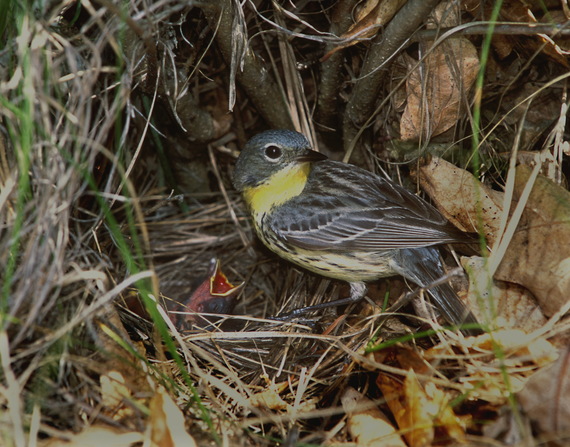In a follow-up post to her December 24 blog about the federally endangered Kirtland's warbler, Kay Charter continues providing insight on the critical pieces to the recovery of this rare songbird - which include mystery, intrigue and discovery of an unlikely threat! Today also marks the final countdown to the finish of the Crowdrise Holiday Challenge where you can make a donation to make sure this recovery effort leads to the Kirtland's warbler singing forever.
In 1923, a brilliant young amateur ornithologist penned an article on the life history of the Kirtland's warbler. He closed with the following: "...this bird is decreasing in numbers. It is greatly to be feared that Dendroica kirtlandii may soon be another of the American birds on the extinct list." The article, printed in a 1924 edition of the American Ornithologists Union's publication, The Auk, was written by a major player in one of the most notorious crimes of the twentieth century. That same year, the author, Nathan Leopold, along with his friend Richard Loeb, kidnapped and then brutally murdered fourteen-year-old Bobby Franks in what the two believed was the perfect crime. (It was not such a perfect crime; the two were soon caught, tried and sentenced to life plus 99 years.)
Because of its historic breeding range, Kirtland's warblers were never numerous, but by the time Leopold and his party visited its nesting grounds that summer, they were aware of its unusually low nesting success. The flawed young genius was the first to attribute sagging population numbers to nest parasitism by brown-headed cowbirds.
Brown-headed cowbirds are brood parasites, meaning they do not build their own nests or raise their own young. This survival mechanism, developed as they followed buffalo across the vast prairies of North America in search of food, has proven to be a challenge for many avian species - especially small songbirds like warblers. Each cowbird hen lays up to 30 eggs in the nests of other species each season, typically resulting in the host parents raising a single cowbird. The host's youngsters rarely survive, resulting in declining populations for many songbirds. For some species, including Kirtland's warbler, brown-headed cowbirds are a relatively new challenge in our state as they were rare until the forests were cleared. Nathan Leopold was correct in his assertion that cowbirds were adversely impacting nesting success of the Kirtland's warbler
Although the Endangered Species Act was not enacted until the end of 1973, the U. S. Fish and Wildlife Service listed the bird as endangered six years earlier. By 1971, only 201 male Kirtland's warblers were counted. By then, cowbird parasitism was widely believed to be the problem; thus the Service began trapping cowbirds the following year. With that effort, nesting results rose from less than one fledgling per nest per year to nearly three per year. In spite of that, however, the overall population numbers remained stagnant. They even declined. From 201 males counted in 1971, the number slumped to a mere 167 in 1987. With cowbird trapping well underway, it was clear that brood parasitism wasn't the only problem for the bird.
The Kirtland's Warbler Recovery Team was formed as a result of the passage of the Endangered Species Act. The team brought Federal and State agencies together to, among other things, manage the bird's habitat. Although it was well-known that Kirtland's warbler nested only on jack pine barrens, further strict habitat requirements were not well understood until a deadly controlled burn got out of control in 1980. Initially, population numbers continued to drop until the 1987 low. Then they began to climb. It was an uneven, but steady increase. This year more than 2,000 males were counted in Michigan. After ninety years of tracking, studying and attempting to aid this iconic breeding bird in our state, just how was that accomplished? Find the answer next time.
Kay Charter is passionate about birds and bird conservation. She is co-owner of Charter Sanctuary, a member of the Kirtland's Warbler Alliance and Executive Director of Saving Birds Thru Habitat in Omena, Michigan (savingbirds.org). Support the incredible comeback of the Kirtland's warbler by donating through the Crowdrise Holiday Challenge.
Huron Pines is a 501(c)(3) organization and an equal opportunity provider with a mission to conserve the forests, lakes and streams of Northeast Michigan. Learn more about our projects by visiting www.huronpines.org
This post has been modified since its original publication.
